-
Gaudí's work is admired worldwide, is a unique and particular style.
His work has greatly influenced the architectural appearance of Barcelona
 and we can find his creations all over the city.
and we can find his creations all over the city.Antoni Gaudí was born in Reus in 1852 and received his degree in architecture in 1878.
From the beginning his designs were different from those of his contemporaries.
The work of Gaudí was greatly influenced by forms of nature, this characteristic is reflected in the size of rounded stones, the twisted wrought iron work and organic forms in decoration, signature of the master architect in Barcelona.
Gaudí also decorated many of his buildings with ceramics, mosaics arranged. This brings another dimension to his buildings, so often forgotten by other architects because he used color.
 The combination of original design, interesting stone and bright colors
The combination of original design, interesting stone and bright colors  in the work of Gaudí is for the visitor a visual experience breathtaking. The Sagrada Familia is the perfect illustration of his work. Indeed, the Sagrada Familia is one of the best known works by Antoni Gaudí in Barcelona. It is a gigantic Basilica whose construction began in 1882 and which should not be ended before twenty years at least. When visiting the monument we see perfectly the color contrast between the stone facade and that of the opposite façade. The style also seems very different from the recent façade to the old facade.
in the work of Gaudí is for the visitor a visual experience breathtaking. The Sagrada Familia is the perfect illustration of his work. Indeed, the Sagrada Familia is one of the best known works by Antoni Gaudí in Barcelona. It is a gigantic Basilica whose construction began in 1882 and which should not be ended before twenty years at least. When visiting the monument we see perfectly the color contrast between the stone facade and that of the opposite façade. The style also seems very different from the recent façade to the old facade.  Gaudí had a very active presence in the direction of the works of the Sagrada Familia, until his death in 1926. He often asked that the work be modified or adjusted until it corresponds exactly to he had in mind. However today, following his idea through drawings made, the work is open to interpretation.
Gaudí had a very active presence in the direction of the works of the Sagrada Familia, until his death in 1926. He often asked that the work be modified or adjusted until it corresponds exactly to he had in mind. However today, following his idea through drawings made, the work is open to interpretation. Another masterpiece of the architect is named “Park Guell” and
Another masterpiece of the architect is named “Park Guell” and  was commissioned by Eusebi Güell who wanted to create a high class private park for Barcelona aristocracy. The Park Güell is composed of stone structures delusional, a working pottery striking and fascinating buildings. We can find a fountain dominated by a dragon or twisted stone columns that seem to have grown in the ground like tree trunks.
was commissioned by Eusebi Güell who wanted to create a high class private park for Barcelona aristocracy. The Park Güell is composed of stone structures delusional, a working pottery striking and fascinating buildings. We can find a fountain dominated by a dragon or twisted stone columns that seem to have grown in the ground like tree trunks. 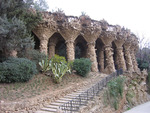 Gaudí was very inspired by nature and its forms and used them in his works. A little higher in the Park Güell there is a terrace which gives
Gaudí was very inspired by nature and its forms and used them in his works. A little higher in the Park Güell there is a terrace which gives  a splendid panoramic view of the park and the city of Barcelona. You will see the same colorful mosaic decorating the bench all around the terrace.
a splendid panoramic view of the park and the city of Barcelona. You will see the same colorful mosaic decorating the bench all around the terrace.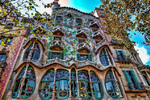 We can also mention the Casa Batllo, one of the two great buildings designed by Antoni Gaudí on the Passeig de Gràcia, the other being La Pedrera. From
We can also mention the Casa Batllo, one of the two great buildings designed by Antoni Gaudí on the Passeig de Gràcia, the other being La Pedrera. From the outside, the facade of the Casa Batllo looks like a bone construction and skulls. These "Skulls" are in fact balconies and the "bones" are colones. Gaudí was inspired by the colors and shapes of the aquatic world to create this building, for example the colors chosen for the façade are those of natural coral. The building was built by Gaudi for Josep Batlló, a wealthy aristocrat, who wanted a home worthy of his class. Sir Batllo lived with his family in the first two floors and rented apartments on the upper floors to other families.
the outside, the facade of the Casa Batllo looks like a bone construction and skulls. These "Skulls" are in fact balconies and the "bones" are colones. Gaudí was inspired by the colors and shapes of the aquatic world to create this building, for example the colors chosen for the façade are those of natural coral. The building was built by Gaudi for Josep Batlló, a wealthy aristocrat, who wanted a home worthy of his class. Sir Batllo lived with his family in the first two floors and rented apartments on the upper floors to other families.I hope you enjoyed all my articles, Barcelona was for me an amazing experience I would like to live again if I could. Not only a city of art, you can find so many beautiful things and places there, and of course, enjoy the really tasty food !
 1 commentaire
1 commentaire
-
Barcelona won the 2014/15 UEFA Champions League with a 3-1 victory over Juventus on Saturday the 6th of June at the Olympiastadion in Berlin, Germany. The Catalans' early opener was wiped out soon after the restart, though they rallied to net a second midway through the second period and a third at the death.
It took just four minutes, 3:24 to be precise, for Barça to score the game's first goal, when Lionel Messi swung a glorious crossfield pass for Jordi Alba out on the left. Andrés Iniesta promptly took receipt of the ball in the box in the penalty area, and laid on a simple finish for Ivan Rakitić to slot home.
It was the start of a few minutes of utter dominance from the Catalans, with Juve completely chasing shadows. Only a smart reaction stop from goalkeeper Gianluigi Buffon prevented Dani Alves from doubling Barça's advantage just 10 minutes after their opener.
As the half wore on, Juve began to steady the ship, and even enjoyed spells of possession in Barça's half. The “bianconeri” scarcely tested keeper Marc-André Stegen, though by the halftime whistle their deficit remained at a single goal. They may have been second-best, but the game was still alive.
It stayed that way early into the second half, despite Barça looking
 back to their terrifying best. They'd cruised through most of the opening period, though they redoubled their efforts after the restart and went close thrice in the opening six minutes.
back to their terrifying best. They'd cruised through most of the opening period, though they redoubled their efforts after the restart and went close thrice in the opening six minutes.However, goalscoring chances are only useful if you take them, and Barça's profligacy was swiftly punished just short of the hour. Carlos Tevez wriggled away from Gerard Piqué and drew a great save from Stegen, only for Álvaro Morata to tap home the rebound. Suddenly Juve were level and in the ascendancy.
 For the first time in the match shots began to rain down on the Barça goal, but they clung on. They also had a player called Messi. With just over 20 minutes to go, the Argentine wonder took the ball on the counter-attack and lashed a low shot towards goal. Buffon could only parry it straight into the path of Luis Suárez, who tapped into the empty net.
For the first time in the match shots began to rain down on the Barça goal, but they clung on. They also had a player called Messi. With just over 20 minutes to go, the Argentine wonder took the ball on the counter-attack and lashed a low shot towards goal. Buffon could only parry it straight into the path of Luis Suárez, who tapped into the empty net.It looked like Neymar had sealed Barça's victory a few minutes later, only for the referee to chalk his goal off for handball. Replays showed it had indeed come off his arm after he failed to make a clean contact with his forehead, but it certainly didn't look deliberate. He looked understandably aggrieved.
That was until the seventh minute of stoppage time, when the Brazilian converted a quick counter-attack to score with the last kick of the match.
The victory gives FC Barcelona their fourth Champions League title in the last 10 years — their fifth in team history — and an unprecedented second treble, adding a layer of reinforced concrete to the Catalans' already rock-solid status as a dynasty for the ages.

While annual modifications to any top-tier squad are inevitable, a steady core of players — led by the Argentinian virtuoso Lionel Messi — has anchored the Catalan club during a run of footballing dominance the likes of which has never been witnessed before. Over the past decade Barça have scooped up titles at a prolific pace with an astounding haul of 24 major trophies in six different competitions.
One of the main cogs to Barça's perennial juggernaut and perhaps the keymaster to the team's on-field personality and unmistakeable style of play has been midfielder and captain Xavi Hernández, who donned the blaugrana shirt for the final time on Saturday night and was duly ceded the prestigious honour of lifting the cup.
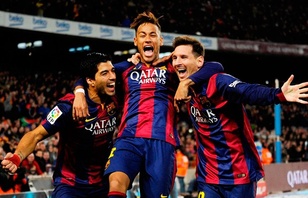 For FC Barcelona's first-year head coach Luis Enrique Martínez, his immense first-year success mimics that of Pep Guardiola, who was also in his first year at the helm when Barça swept the same three titles back in the 2008/09 season. "Congratulations to all the Barça fans and family. It'll be a long night and then tomorrow we have the parade," Luis Enrique said on the field, before humbly adding, "After all these games, I'd just like to thank everyone who put their trust in me."
For FC Barcelona's first-year head coach Luis Enrique Martínez, his immense first-year success mimics that of Pep Guardiola, who was also in his first year at the helm when Barça swept the same three titles back in the 2008/09 season. "Congratulations to all the Barça fans and family. It'll be a long night and then tomorrow we have the parade," Luis Enrique said on the field, before humbly adding, "After all these games, I'd just like to thank everyone who put their trust in me."Saturday's win means they'll now have a chance to equal their 2009 record take of six championships in one year. Winning La Liga, the Spanish Cup, and the Champions League has earned them another shot at the Spanish and European Super Cups — to be disputed in August — as well as the FIFA Club World Cup, scheduled for December. Barça will almost certainly go into all three as the heavy favourites.
 votre commentaire
votre commentaire
-
Hi everybody !! I spoke a lot about Spain and traditions but let's have a little more information about the Geopolitic situation of the country.
Since Franco's death in 1975, more than thirty years have passed during which Spain has experienced profound political, social, economic and cultural evolutions. Such changes have made the country an essential partner in the European Union and its political role on the international stage has grown. Nowadays, Spain is a stable democracy like its European partners.
Presentation of country’s government
Spain is a multiparty constitutional monarchy where the king is head of state and the prime minister is head of government. Executive power is exercised by the government while legislative power is vested in parliament. The judiciary is independent of the first two.
Executive Power
Spain is defined in its constitution as a constitutional parliamentary monarchy, reflecting that the king is both limited in its powers by a constitution and by the existence of two chambers elected deliberative, for the first by the people and for the other by the autonomies.
King Philip VI reigns since 2014. He is head of state and various autonomies, that is why the title of King of Spain does not match in practice with the exercise of the functions established by the Constitution 1978 in the sense that the statutes of autonomy can award their own functions. Thus the presidents of autonomies are appointed by the King on the proposal of autonomous parliaments, while the director of the State within communities himself is appointed by the Cabinet by the President of the Central Government.
The king also opens new legislatures of Cortes Generales and Autonomous Parliaments. He exercises the supreme command of the armed forces and is the highest representative of the country in international relations. The King is the Head of State, symbol of its unity and its sustainability. As such, the King has a right of entry and presence in the Congress of Deputies and then of presidency, what other European monarchies do not usually allow.
Executive power is entrusted to the government, composed of the president, vice-presidents and ministers. The president is appointed by the Congress of Deputies the proposal by King and earned a 4-year term if its application is accepted by the majority of the Congress of Deputies. The government's primary role is to lead the domestic and foreign policy, civil and military administration and the defense of the state. It also exercises the executive function and regulatory power under the constitution and the law. Moreover, it is one that manages the budget of the Spanish state. The government is responsible jointly and severally political actions before the Congress of Deputies, before whom a weekly basis to account for its management.
Legislative Power
Spain has an imperfect bicameral parliament. The Cortes Generales are the name of both houses of Parliament represent the Spanish people. They are formed by the Congress of Deputies and the Senate.
The Congress of Deputies is composed of 350 deputies elected by proportional representation list system for a period of four years. The role of Congress is to exercise legislative power, that is to say to control the action of the government by voting the bills. This room is also responsible for approving the budget proposed by the government. The room also has the power to pass a motion of censure to overthrow the government.
The Senate is composed of Spain territorially four senators are elected in each of the 47 provinces of the peninsula, 16 are elected from the three island provinces, and Ceuta and Melilla elect two each; What goes up to 208 senators. The parliaments of the 17 autonomous regions also elect one senator and a senator for each additional million inhabitants in their territory. Currently, the Senate consists of 264 senators. Its role is to exercise legislative power by having a veto over legislative proposals accepted at the Congress of Deputies.
Nationally there are two dominant political parties, (the left-leaning PSOE and right-wing PP) which make it extremely difficult for any other formation or coalition to achieve an electoral majority in the bicameral Cortes Generales (consisting of both the national Congress of Deputies and regional representation in theSenate).
Judicial Power
Although having autonomies, Spain does not separate the judiciary and the courts wich are competent in areas of norms of central government or autonomous standards. A Constitutional Court has exclusive features to address all issues relating to the Constitution, the statutes and standards arising, it is also the supervisory body of referenda and electoral results.
Autonomies have no equivalent bodies, their status before being accepted session of Congress of Deputies, and subject to control before promulgation by the Constitutional Court, all provisions contrary to the Constitution are canceled and the Constitutional Court has jurisdiction over issues of powers between the State and the autonomies but also between these institutions, whether central or local institutions.
A Supreme Court judge in his final appeal cases being submitted by the lower courts, it is also the first instance court for crimes involving foreign officials and certain offenses that can lead to lower courts of bias. It is not the body regulating the judiciary, this prerogative is exercised by the Superior Council of the Judiciary, which manages, organizes, structure the judiciary.
There are in Spain, as in many democracies specialized courts in specific areas (trade, family, terrorism ...).
The courts of appeal and district courts are located throughout the territory.
External political situation
Spanish foreign policy is traditionally Atlanticist and European, with Mediterranean and Latin American tropism, with highlighting of the role of the Spanish language, viewed as an economic instrument of great importance.
The transatlantic link for Rajoy is that the United States must become "the most important partner of Europe." He clearly announced that the Popular Party is "just as pro-European as Atlantic". This position is reflected in support for the rapid conclusion of the trade agreement EU / USA, still under negotiation.
The Mediterranean commitment with regard to the neighborhood of the EU and the relations with Morocco are a priority. With this large neighbor, the second commercial partner of Spain outside the EU, tension is seen about the enclaves of Ceuta and Melilla, of illegal immigrants, or the Western Sahara (file on which the Spanish Government, ex- colonial power, intends to pursue a policy of "active neutrality" in alignment with the positions of the United Nations Security Council). Rajoy made on 18 January 2012, his first visit abroad in Rabat, during which he brought a strong support to the reforms of Mohammed VI who "places Morocco at the forefront of the Arab world ". With Algeria, Spain seeks to preserve its economic and commercial interests. Finally, Madrid is particularly concerned about the security situation deteriorated in Libya, and risks destabilizing the Sahel and Tunisia.
Moreover, Spain maintains dense relations with the Latin American space (important human, historical, social, cultural, political, economic and linguistic). A Secretary of State is also responsible for cooperation and relations with the Ibero-American area. Spain has to rely on strong partners like Mexico and especially Brazil to play more effectively its role of "bridge between Europe and Latin America," although this ambition can confront some obstacles (sudden nationalization of Repsol in Argentina, political differences between Madrid and the Latin American States led by the Bolivarian governments). The support of the Colombian peace process and transition in Cuba, are now priorities for Madrid.
Internal political situation
The traditional parties are in a delicate situation in this election year. (March 22: early regional elections in Andalusia; 24 May: municipal elections and "autonomic" in most regions; September 27: early regional elections in Catalonia that the President of the Generalitat, Artur Mas, wish to become a "referendum" for independence; general elections late in the year).
The political context is marked by the rise of protest parties like Podemos (the radical left party from the movement of the "indignados" created a few months before the elections in May 2014), and Ciudadanos (the original center-left party Catalan).
After the abdication of his father, Juan Carlos, Prince Felipe took the oath and became King of Spain under the name of Felipe VI, before Parliament on 19 June 2014. The King has indicated a desire to pass the torch the "new generation", a new young and dynamic king, he considers ready for the challenges of tomorrow, while embodying "stability, a key element of the identity of the monarchy." The King is the Head of the Spanish State, symbol of its unity and permanence. It is a constitutional monarch without real political power but with a magisterial influence.
The new King is trying to renew the institution. In his inaugural speech, he said he intends to be the king of a constitutional monarchy restored, exemplary and law-abiding, anxious to serve his country and to all citizens, aware of the economic and social challenges.
Regional Conflicts - Catalan independence
As the Scots, part of Catalans want independence. Proud of their language and their culture, many of the 7.5 million Catalans do not feel treated as they would by the Spanish central government.
Catalunya is one of the most powerful and richest regions of Spain. With 7.5 million inhabitants (about 47 million that the country), the Catalans produce about 20% of the wealth of Spain and the region accounts for 25% of Spanish imports. Located in the northeast of the country, Catalonia has a status of "autonomous community", with a Parliament and a clean government. Health, education and social services, particularly within its prerogatives. Catalonia has two official languages: Spanish (or Castilian) and Catalan, and one can also speak Occitan.
Barcelona, capital of the region and major Mediterranean port, the second largest city of Spain. It is a major economic and cultural center of Europe. When they do not attend a match of Barça, the Catalans working in the industry (automotive, pharmaceutical ...), tourism, services (banking, real estate ...) ... In late October, Catalonia had an unemployment rate of 19 %, indeed high, but significantly less than the actual 23.67% posted for all of Spain.
The notion of Catalan identity (traditions, culture, language, flag ...) has always been very strong in this region. If Catalonia has never been an independent state, the region has very old roots. Not until the twentieth century that the Catalan nationalism actually emerges. However, it remains largely minority.
The separatist shift of much of the Catalan public opinion is in 2010 when the Spanish constitutional court rejects the new Statute of Catalonia, the Estatut. This text, which expanded the autonomy of Catalonia, recognized the existence of the Catalan nation. Many Catalans feel betrayed when this new status was approved by the Spanish and Catalan parliaments.
Since then, every September 11, the day of the Catalan National Day (which is, paradoxically, the commemoration of defeat for the Catalans), is the opportunity of an impressive show of force. In 2014, there were between 550,000 and 1.8 million people in the streets of Barcelona. An immense crowd invaded the main avenues of the city, forming a V (like "vote"), to claim the right to hold a referendum. The previous year a "Catalan way" towards independence had been represented through a human chain of 400 km.
The government of the Popular Party (right) stuck by its base, very unionist. The Socialist Party, tends to favor greater autonomy of Catalonia, remains opposed to the Catalan independence.
Catalonia's parliament approved a referendum for its independence from Spain on Sept. 19, 2014. Later that month, Catalan President Artur Mas scheduled the vote for Nov. 9, 2014. However, the Spanish Constitutional Court suspended the referendum after hearing the Spanish government's appeal on Sept. 29. Spain's government appeal called for all of Spain, not just one region, to decide on the future of the country. Therefore, Catalonia held an unofficial vote on Nov. 9 for their independence. Only 37% turned out, but of those, 81% voted for Catalonia's independence. Spain's government refused to acknowledge the vote, calling it invalid.
I hope you enjoyed this article, see you soon to learn more about Spain !
 votre commentaire
votre commentaire
-
Hi everybody !
What better than the day of Sant Jordi to speak about Catalan traditions or culture?
St Jordi's day is Saint George's Day in Barcelona and Catalunya and it is the most romantic day of the year. It is also called "El Día de los Amantes," which means Lovers Day and sometimes called "El día de la Rosa," which means the Rose Day. St. Jordi day is not a public holiday in Barcelona, so shops are open as usual and the main streets as the Rambla Catalunya are crowded.
St. Jordi is Catalunya's version of Valentine's Day and is a one day festival of romance, roses and books all inspired by the legend of Saint George on 23rd April every year. St. Jordi is the patron saint of Catalunya and is celebrated on 23rd April to commemorate his death on that date in the year 303 AD. The legend of Saint George, which you probably have heard, is that he slew a dragon to save a princess. He then plucked a red rose for the princess from a rose bush, which had sprouted on the exact spot where the dragon's red blood had spilled.
On Sant Jordi's day the men in Barcelona and Catalunya give their sweetheart a red rose, and in recent years a new Sant Jordi tradition is that the ladies give the men a book to commemorate both the death of Shakespeare and Cervantes.
This celebration is only one of many feasts that the Catalans celebrate.
For example, the beginning of March is marked by the carnival which begins in Spain with "Dirty Thursday". In Barcelona this day is called “Jueves Ladero” – “Greasy Thursday”, or “Dijous Gras” in Catalan. This day is dedicated to the "Greasy" and "Vice" and celebrated with many festivals in which vast amounts are eaten.
The weekend belongs to the Carnival Guilds. The Rambla is highlighted due to the big carnival Parade with loads of colorful decorated carriages and carnival Groups.
 On Ash Wednesday the carnival comes to an end with the funeral of the sardine. The King of Carnival dies and is buried in his grave in a funeral cortège, accompanied by his widow and companions - the colorful costumes are appropriately exchanged to black mourning clothes. Traditionally, on this day fish is eaten.
On Ash Wednesday the carnival comes to an end with the funeral of the sardine. The King of Carnival dies and is buried in his grave in a funeral cortège, accompanied by his widow and companions - the colorful costumes are appropriately exchanged to black mourning clothes. Traditionally, on this day fish is eaten.Easter is also here a special celebration. Traditionally, Easter Week or "Semana Santa" begins on Palm Sunday and ends on Easter Monday.
Easter is one of the best times to spend a few days in Barcelona. Spring is already here, tourists are less numerous than in summer, and parades of religious processions are impressive.
Palm Sunday is the last Sunday of Lent and Sunday just before Easter. There is a religious procession around Barcelona Cathedral, which dates from the 13th century. It is located in the Barrio Gotico, the artists' quarter. The parade is intended to bless the branches of Palm which are then offered by the gofathers to their godchildren.
During the Holy Friday we can attend the parade given in
 honor of the "Virgen de la Macarena", the Patron Saint of Barcelona. The parade takes place in front of the Church of Sant Agusti in the Raval to reach the Cathedral of Barcelona in the Barrio Gòtic. This procession is characterized by “Costaleros”: members of religious congregations carrying a large statue of Mary through the city.
honor of the "Virgen de la Macarena", the Patron Saint of Barcelona. The parade takes place in front of the Church of Sant Agusti in the Raval to reach the Cathedral of Barcelona in the Barrio Gòtic. This procession is characterized by “Costaleros”: members of religious congregations carrying a large statue of Mary through the city. The "Semana Santa" is also the best time to test the traditional Catalan dishes. The Holy Friday, Christians eat fish instead of meat, often of cod. You can also try different pastries and biscuits as "Buñuelos" and "Mona de Pascua". A Buñuelo is a kind of donut stuffed with chocolate and La Mona de Pascua is a traditional recipe which is also given to godchildren on Palm Sunday.
The "Semana Santa" is also the best time to test the traditional Catalan dishes. The Holy Friday, Christians eat fish instead of meat, often of cod. You can also try different pastries and biscuits as "Buñuelos" and "Mona de Pascua". A Buñuelo is a kind of donut stuffed with chocolate and La Mona de Pascua is a traditional recipe which is also given to godchildren on Palm Sunday.In general, life in Barcelona is much more relaxed than the one we have in France. Indeed, businesses are often not open until 10 or 11 am and close between 14 and 16 pm to re-open three or four hours. People do not run in the subway and are relatively quiet.
However, the Catalans are able to move mountains and be very
 well heard when it comes to their independence. And this can even be seen regarding the Catalan Flag hung on almost every balcony Barcelona.
well heard when it comes to their independence. And this can even be seen regarding the Catalan Flag hung on almost every balcony Barcelona.The flag of Catalunya, known popularly as the Catalan senyera, is
 the traditional flag
the traditional flag
four horizontal bands of red on gold, the old colors of the coat of arms of the House of Barcelona and then the coat of arms of Catalonia and the Crown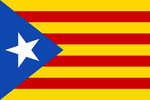 of Aragon. It is official since 1979. But Catalan recently modified it and created a new one, the estelada, which is the flag that symbolizes the demand for independence of Catalunya and the Catalan country compared to Spain and France. It consists in a senyera to which a triangle luff wearing a star in the center was added.
of Aragon. It is official since 1979. But Catalan recently modified it and created a new one, the estelada, which is the flag that symbolizes the demand for independence of Catalunya and the Catalan country compared to Spain and France. It consists in a senyera to which a triangle luff wearing a star in the center was added.Barcelona has also a real distinctive and beautiful architecture. Bold, brash, colourful, distinctive,
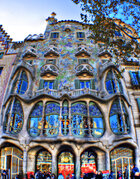 harmonious,varied and unique are just a few adjectives that come to mind when
harmonious,varied and unique are just a few adjectives that come to mind when describing it. Barcelona has successfully blended the old and the new in a way that makes this city simply breathtakingly beautiful. There is nothing more enjoyable than strolling around the streets of Barcelona and taking in the atmosphere that radiates out from the architecture. Traditional Catalan Gothic architecture such as the Iglesia de Pi church is reserved and stoic in its design, but just a 5 minute walk away we have the Barcelona Cathedral with is beautiful arches and facade. A short metro ride we have the famous Sagrada familia Basilica which towers brush against the sky.
describing it. Barcelona has successfully blended the old and the new in a way that makes this city simply breathtakingly beautiful. There is nothing more enjoyable than strolling around the streets of Barcelona and taking in the atmosphere that radiates out from the architecture. Traditional Catalan Gothic architecture such as the Iglesia de Pi church is reserved and stoic in its design, but just a 5 minute walk away we have the Barcelona Cathedral with is beautiful arches and facade. A short metro ride we have the famous Sagrada familia Basilica which towers brush against the sky.
Central Barcelona can be separated into three main areas.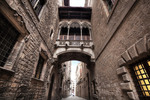 On one side, the old town or Barri Gòtic which was the original Barcelona characterised by winding old streets and tall dark buildings ancient buildings. And on the other side, the Raval area which was an extension to the original old town and finally Eixample which is the large organized "grid" structure area that was appended to the old town. Each area has its own unique and distinctive character.
On one side, the old town or Barri Gòtic which was the original Barcelona characterised by winding old streets and tall dark buildings ancient buildings. And on the other side, the Raval area which was an extension to the original old town and finally Eixample which is the large organized "grid" structure area that was appended to the old town. Each area has its own unique and distinctive character.To conclude, Barcelona is a marvel in terms of architecture. It is also a really pleasant city to live organized around various events, religious or not.
 votre commentaire
votre commentaire
-
Hi everybody!
It has now been two months since I arrived in Barcelona, which allowed me discover a little the city.
I traveled by car from France and the first weird thing I noticed was the way Spanish people drive. Indeed, in Barcelona, the roads are strangely constructed and turn around is almost impossible. So we nearly got arrested several times with my dad because we had difficulty in locating us.
We planned to spend a week in Barcelona to look for an apartment before the start of my classes. In Barcelona, there are very few studios to rent because the apartments are often very large. Thus, sharing a flat is a phenomenon more than widespread and even recommended. I visited about 10 different apartments and nothing pleased me until finally, we fall on a sign which stated that a room was available in a residential area. Barely the doorstep past, I knew this was the right apartment.
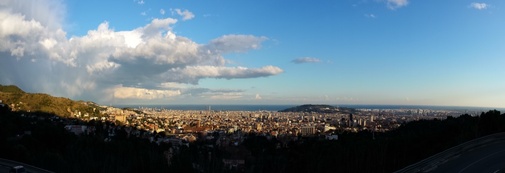
But time passed very quickly and once my apartment found, the first day of school arrived. My university is called Universitat Abat Oliba CEU. It is located near the Tibidabo Mountain where we have a magnificent view of Barcelona, half an hour from the city center.The Universitat Abat Oliva CEU finds its origin in the University Center Abat Oliva CEU, which created the San Pablo-CEU Foundation in 1973 through an affiliation agreement and collaboration with the University of Barcelona. Classes began in its first Avenida Pearson headquarters in Barcelona in 1974 and since then, have trained over 8,500 graduates.
In 1993 it moved to the campus of Bellesguard, and
 as Teaching Higher Education Center Abat Oliva CEU, all the degrees in Law and Business Administration were united, and the first cycle degree in Economics began.
as Teaching Higher Education Center Abat Oliva CEU, all the degrees in Law and Business Administration were united, and the first cycle degree in Economics began.Ten years later, the new Universitat Abat Oliva CEU is recognized by Law (July 2003) by the Parliament of Catalonia, creating two centers in Barcelona: the Faculty of Social Sciences and the School of Engineering.
My first day of class started very badly. Indeed, as my university is far from the city center, I have to spend almost one hour to go there via public transports. I did not expect that the trip would last as long, so I arrived a few minutes late. But fortunately, the welcome session had not yet begun. The people in charge of the Erasmus student taught us the basic rules we had to follow as for example, not to drink or to eat in class. They presented us various and numerous school associations. They gave us some information about the city itself and two police officers came to make a presentation about the dangers of Barcelona.
 After this welcoming session, the university had provided us an evening in a bar in Barcelona located in the center of the city for us to do an idea of the atmosphere that prevails. I was then able to realize that life in Barcelona is offset from the one I had in France. Indeed, people usually have lunch and dinner much later than in France and therefore they go out later. The next day, a tour of the old part of Barcelona called Barrio Gotico was organized so we could discover the wonderful architecture of this area and especially its history with lots of anecdotes that the guide was happy to tell us.
After this welcoming session, the university had provided us an evening in a bar in Barcelona located in the center of the city for us to do an idea of the atmosphere that prevails. I was then able to realize that life in Barcelona is offset from the one I had in France. Indeed, people usually have lunch and dinner much later than in France and therefore they go out later. The next day, a tour of the old part of Barcelona called Barrio Gotico was organized so we could discover the wonderful architecture of this area and especially its history with lots of anecdotes that the guide was happy to tell us.This was now time to choose my classes. This was quite a difficult step but I finally succeeded to make my schedule. My school subjects are all related to International Trade and I study for example Global Entrepreneurship, Strategic Marketing and Globalization and Geopolitics. As in ESDES, teachers are not necessarily skilled teachers but often have their own business and are involved in the university to share with us their experience, which makes all my classes very interesting and really alive. In each of my classes, I am with one Erasmus student at least. I have three classes in Spanish and three in English which allows me to practice these two languages. The Erasmus students come from all around the world and even if the majority is from Mexico, there are also Norwegian people, German ones, and people coming from the United States too. It was at this time that I realized that some stereotypes concerning people nationalities were entirely justified and that others had no meaning. But in a general way, it was funny and very interesting to see people different points of view about very basic things that change depending on the country in which they live. For example, it is not a problem for Mexican people to be late whereas for German people it is a real shame. Moreover, Norwegian guys are really good to speak other languages and especially English whereas French people encounter difficulties.
These two month I already spent here were full of discoveries I will talk a little bit more in future articles. Barcelona is a real beautiful city, would it be in an architectural point or in a human one. People are really open-minded even if Catalan people claim their independence. My Erasmus stay started very well and keeps making me happier and more curious.
 1 commentaire
1 commentaire Suivre le flux RSS des articles
Suivre le flux RSS des articles Suivre le flux RSS des commentaires
Suivre le flux RSS des commentaires





